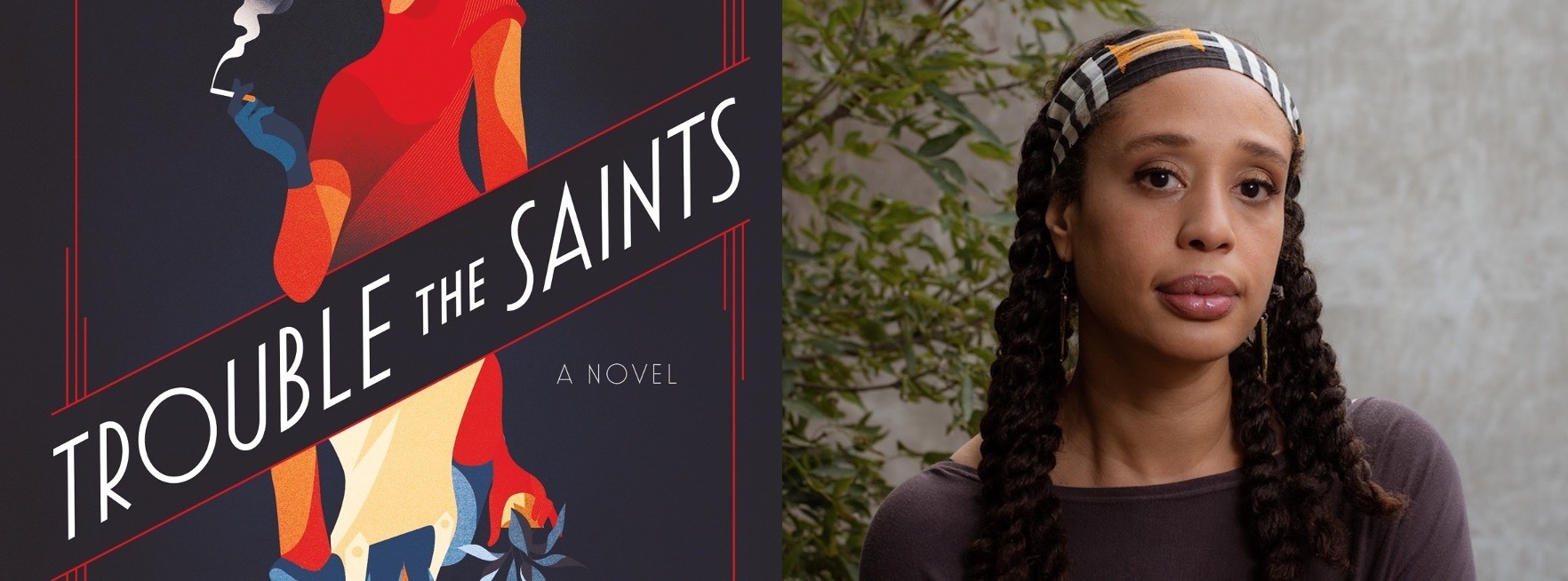Even with its enduring peculiarities, the pandemic has had its way of neutralizing New York. For many of us, it’s been reduced to a small apartment and a fading superiority complex of what the city has to offer over small towns, rationalizing the cost of living against an exodus to an undetermined somewhere. And if you’re anything like me, recent depictions of NYC feel eerie, almost like an urban version of the uncanny valley—resembling the city but uncomfortably divorced from an obvious reality. A solution I’ve found is leaning into NYC-based historical fiction, which is why I appreciated that Tor Books was willing to sponsor this review of Trouble the Saints.
Set in 1940s Harlem, Trouble the Saints begins under the guise of standard noir fare: Phyllis—or Pea, as she’s called by those close to her—is a reluctant assassin caught between the mob, her conscience, and what could maybe be a normal life. What follows, though, is an exploration of race, power, and justice, as Pea, her lover Dev, and her best friend Tamara struggle with the fantastical twist of the 350-page novel: they have the gift of “hands,” a rare gift granted to people of color.
Their gifts take different forms that implicitly frame their personalities, like a bending style from Avatar: The Last Airbender. Phyllis’s is one of dexterity and aim, lending her to violence as she uses throwing knives to kill the enemies of a mob boss named Vic, who would point her towards a target with a loose explanation to why they deserved to die. Dev is a bartender at Vic’s club and has the gift of being able to sense when someone is in danger; Tamara can predict people’s futures through a deck of cards.

Each character is given a POV section, beginning with Phyllis, followed by Dev, and then Tamara after a twist that’s too significant to spoil here despite happening in the first third of the book. What I can prepare you for, though, is the appropriate setting for your suspension of disbelief, as Trouble the Saints chooses to forgo a deeper explanation of the characters’ powers. Within the world, “hands” are accepted as rare but existent, and you’re left to fill in the blanks with divinity, mutation, or whatever magic of your choosing that would give Black people an exclusive gift for our own survival.
But while Pea, Dev, and Tamara share supernatural power, their abilities to navigate socially in the 1940s are molded differently by race. Phyllis can pass as white, Tamara is Black, and Dev is Indian. My favorite depiction comes from Dev, who captures the experience of he and Pea being seen together: “Either one of us alone seems to occupy that liminal space between ‘acceptable’ and ‘colored,’ but together we are unequivocally Not White.”
Their proximities to Blackness and how it’s leveraged in relationships adds complexity to the post-Harlem Renaissance era and is a fitting direction for where our focus is best held: It doesn’t matter the source of the divine power, but how Pea, Dev, and Tamara choose to use it. It reminds me of reviewing Incognegro, which would be a fitting accompaniment—set a decade earlier but also in NYC as a light-skinned reporter’s ability to pass across the color line is a superpower in itself.
As Trouble the Saints is broken into three equal sections, the natural result is that the format lends to three climaxes. The downside takes form in an anchoring bias that cuts twice: meeting Phyllis first leads you to believe that she’s inherently most important, while also making you want more of her perspective as the story goes on. Despite Tamara being my favorite character in hindsight, Phyllis and Dev were enough to distract me from my growing affection until the book’s end, where I’d become victim to not knowing what I’ve got ‘til it’s gone.
Its most interesting allure, though, is its ongoing themes of morality and choice, or the illusion of them. Expect a multidimensional approach to the context of the early 1940s, complete with World War II, being non-white in America, and misogyny, and how its characters imperfectly wade through it as they hurt, heal, protect, and betray. That coupled with charming descriptions of New York neighborhoods and local references to its Black works of art—think Langston Hughes’s The Ways of White Folks and Zora Neale Hurston’s Their Eyes Were Watching God—are more than enough to make Trouble the Saints a wonderfully deep read for the forlorn New Yorker’s heart.
Overall, Trouble the Saints is a great escape and a recommended addition to your TBR pile. If you’d like more insight into the process behind the book, I spoke with author Alaya Dawn Johnson in an interview on her experience, which you should read here. Trouble the Saints is available now wherever you get your books, but of course, I recommend your local indie. In the meantime, you can begin the first chapter.



Show Comments